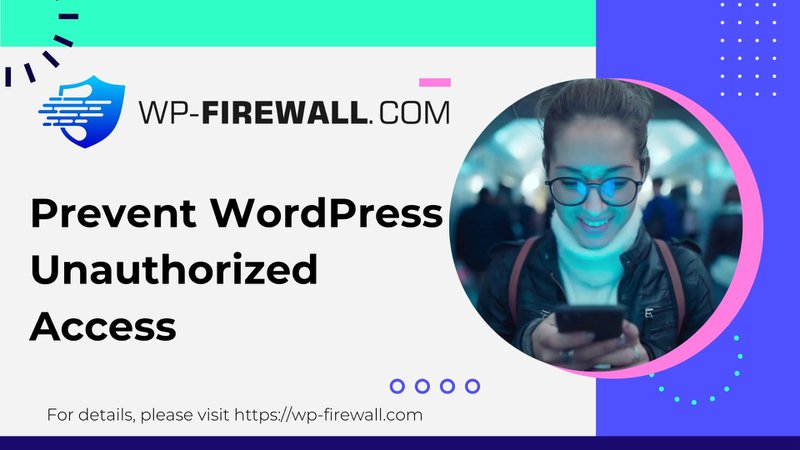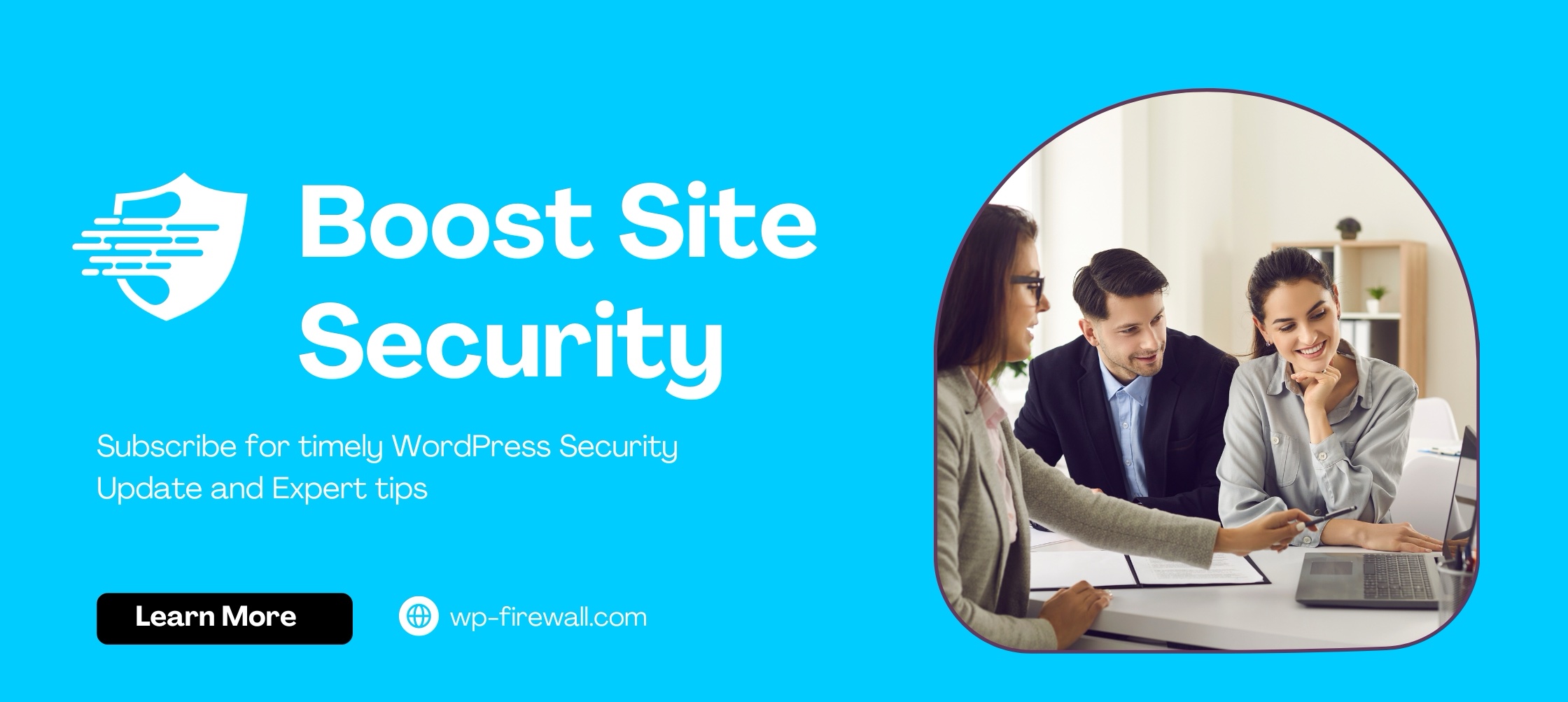
WordPress 권한 상승 이해 및 무단 액세스 방지 방법
어느 날 아침 일어나서 WordPress 사이트가 침해당했다는 것을 알게 되었다고 상상해 보세요. 관리자 권한이 있는 익숙하지 않은 사용자 계정이 나타났고, 설정이 변경되었으며, 스팸 콘텐츠가 페이지를 범람시키고 있습니다. 이 악몽 같은 시나리오는 많은 WordPress 사이트 소유자에게 현실이며, 종종 권한 상승이라고 알려진 보안 침해의 결과입니다.
이 블로그 게시물에서는 권한 상승의 개념, WordPress에서 어떻게 나타나는지, 사이트를 보호하기 위한 실행 가능한 전략을 자세히 살펴보겠습니다. 선도적인 WordPress 방화벽 플러그인 공급업체이자 보안 서비스 공급업체인 WP-Firewall은 이러한 위협으로부터 사이트를 보호하는 데 도움을 드리고자 최선을 다하고 있습니다.
WordPress의 권한 상승이란 무엇인가요?
WordPress의 맥락에서 "권한"은 사용자 계정에 할당된 권한 또는 기능을 말합니다. 이러한 권한은 관리자, 편집자 또는 구독자와 같은 역할에 따라 사용자가 사이트에서 할 수 있는 일과 할 수 없는 일을 지시합니다. 권한 에스컬레이션은 사용자가 가져야 할 것보다 더 많은 권한을 얻어 지정된 역할을 넘어서는 작업을 수행할 수 있을 때 발생합니다.
예를 들어, 편집자가 갑자기 관리자처럼 플러그인과 설정을 관리할 수 있게 되는 것은 권한 상승의 전형적인 사례입니다. 이는 코딩 오류, 플러그인이나 테마의 취약성 또는 잘못된 구성으로 인해 발생할 수 있습니다. 해커는 이러한 취약성을 악용하여 무단 액세스를 얻고, 사이트 데이터를 조작하고, 맬웨어를 설치하거나, 심지어 사용자를 자신의 웹사이트에서 잠그기도 합니다.
권한 상승은 어떻게 발생합니까?
권한 상승은 다양한 취약성과 잘못된 구성을 통해 발생할 수 있습니다. 다음은 이것이 발생할 수 있는 몇 가지 일반적인 방법입니다.
1. 플러그인 및 테마의 취약점
오래되었거나 코딩이 형편없는 플러그인과 테마는 해커의 관문이 될 수 있습니다. 플러그인과 테마를 최신 상태로 유지하지 않으면 알려진 취약점이 있는 이전 버전이 악용될 수 있습니다. 예를 들어, 사용자 등록 플러그인의 최근 취약점은 70,000개 이상의 사이트를 위험에 빠뜨렸습니다.
2. Nulled 플러그인 및 테마 사용
무효화된 플러그인과 테마에는 종종 악성 코드가 내장되어 있습니다. 공격자는 이 코드를 사용하여 백도어를 이식하여 사이트에 대한 은밀한 액세스를 허용할 수 있습니다. 이는 데이터 침해, 데이터 손실 또는 심지어 사이트 전체 인수로 이어질 수 있습니다.
3. 인증 메커니즘 파괴
해커는 사용자 열거 또는 피싱 공격을 통해 인증 메커니즘을 깰 수 있습니다. 사용자 열거는 사이트에서 유효한 사용자 이름을 식별하는 것을 포함하며, 이는 무차별 대입 공격의 대상이 될 수 있습니다. 피싱 공격은 사용자를 속여 사기성 이메일이나 사이트를 통해 로그인 자격 증명을 제공하도록 합니다.
4. SQL 주입(SQLi) 및 크로스 사이트 스크립팅(XSS) 공격
약한 입력 검증을 통해 해커는 악성 SQL이나 스크립트를 주입하여 데이터베이스를 조작하거나 사용자 세션을 하이재킹할 수 있습니다. 데이터베이스에 대한 간소화되거나 보안되지 않은 액세스로 인해 공격자가 특권 작업을 실행하기 쉽습니다.
5. 잘못 구성된 사용자 역할 및 권한
사용자 역할을 잘못 할당하거나 너무 광범위한 권한을 부여하면 남용의 기회가 생길 수 있습니다. 예를 들어, 구독자여야 할 사람에게 편집자 역할을 할당하면 권한 상승으로 이어질 수 있습니다.
6. WordPress 파일에 직접 액세스
파일 인덱싱을 통해 WordPress 파일에 직접 액세스하면 민감한 파일이 노출되어 권한 상승으로 이어질 수 있습니다. 파일 인덱싱을 비활성화하는 것은 무단 액세스로부터 보호하는 데 중요합니다.
권한 상승 공격을 식별하는 방법은?
권한 상승 공격을 식별하는 것은 어려울 수 있지만 사이트의 보안을 유지하는 데 필수적입니다. 주의해야 할 몇 가지 위험 신호는 다음과 같습니다.
1. 설정의 예상치 못한 변경
사이트 설정에서 본인이 하지 않은 변경 사항을 발견하면 주요 경고 신호입니다. 사이트의 활동 로그에서 인식하지 못하는 사용자와 항목을 확인하세요.
2. 새 사용자 계정 및 알 수 없는 사용자 계정
정기적으로 사용자 목록을 확인하세요. 관리자나 편집자와 같은 높은 역할을 가진 새로운 사용자가 승인 없이 나타나면 권한 상승 공격을 나타낼 수 있습니다.
3. 무단 콘텐츠 변경
게시물, 페이지 또는 미디어 파일에 대한 승인되지 않은 변경은 권한 상승의 강력한 지표가 될 수 있습니다. 승인하지 않은 콘텐츠 수정에 주의하세요.
4. 활동 로그의 의심스러운 활동
여러 번 실패한 로그인 시도, 예상치 못한 역할 변경 또는 익숙하지 않은 IP 주소와 같은 비정상적인 활동에 대한 활동 로그를 검토합니다. 이러한 로그에 기록된 의심스러운 작업은 진행 중이거나 시도된 권한 상승 공격의 지표를 보여줄 수 있습니다.
권한 상승 공격을 해결하는 방법?
WordPress 사이트가 권한 상승 공격의 희생자가 되었다고 의심되는 경우 신속하게 조치를 취하는 것이 중요합니다. 효과적으로 대응하기 위한 단계별 가이드는 다음과 같습니다.
1. 일시적으로 웹사이트를 삭제하세요
추가적인 무단 액세스와 손상을 방지하기 위해 일시적으로 웹사이트를 다운시키세요. 문제를 해결하는 동안 방문자를 유지 관리 페이지로 리디렉션하여 정보를 제공하세요.
2. WP-Firewall을 사용하여 웹사이트 검사
WP-Firewall의 강력한 보안 도구를 사용하여 웹사이트를 철저히 검사하세요. 이렇게 하면 악성 코드, 맬웨어 또는 의심스러운 활동을 식별하는 데 도움이 됩니다.
3. 모든 비밀번호 재설정
모든 관리자 및 사용자 비밀번호를 즉시 재설정하고 이 변경 사항을 모든 사람에게 알리십시오. 모든 사용자 계정, 특히 권한이 높은 계정은 강력하고 고유한 비밀번호를 사용해야 합니다. 이 단계는 공격자가 손상된 자격 증명을 재사용하지 못하도록 하는 데 중요합니다.
4. 사용자 계정 감사
귀하의 사이트에서 사용자 계정에 대한 완전한 감사를 실시합니다. 의심스러워 보이거나 귀하의 지식 없이 생성된 모든 계정을 제거합니다. 합법적인 사용자의 역할과 권한이 적절한지 확인합니다.
5. 의심되는 플러그인 또는 테마 제거
공격의 진입점이 될 수 있는 의심스러운 플러그인이나 테마를 제거하세요. 모르는 사이에 설치되었는지 또는 이름이 의심스러운지 식별하세요. 때로는 보안을 위해 일시적으로 기능을 희생해야 할 수도 있습니다. 재설치를 고려하기 전에 이러한 구성 요소가 취약성이 있는지 철저히 검사했는지 확인하세요.
6. 사이트 솔트 및 보안 키 재설정
기존 세션과 쿠키를 무효화하여 보안 계층을 추가하려면 사이트의 솔트와 보안 키를 재설정하세요. WP-Firewall은 해킹 후 정리 서비스의 일부로 이 기능을 제공하여 사이트의 인증 데이터를 보다 쉽게 보호할 수 있습니다.
7. 코어, 플러그인 및 테마 업데이트
WordPress 코어, 플러그인, 테마가 최신 상태인지 확인하세요. 이전 버전의 취약점은 공격의 일반적인 진입점이 될 수 있습니다. 정기적인 업데이트는 보안 갭을 패치하고 사이트를 위협으로부터 보호하는 데 필수적입니다. WP-Firewall 사용자는 업데이트 프로세스를 더 안전하고 원활하게 만드는 스테이징 사이트 및 자동 백업과 같은 기능의 이점을 누릴 수 있습니다.
8. 2FA 또는 CAPTCHA 구현
아직 하지 않았다면 로그인 프로세스에 2단계 인증(2FA) 또는 CAPTCHA를 추가하세요. 이러한 보안 조치는 공격자가 극복해야 할 또 다른 장애물을 추가하여 무단 액세스 위험을 크게 줄입니다.
9. 사이트 모니터링
공격 후 얼마 동안 사이트를 주의 깊게 살펴보세요. 정기적인 보안 검사와 활동 모니터링을 통해 새로운 의심스러운 활동을 일찍 감지하여 필요한 경우 신속하게 대응할 수 있습니다.
권한 상승 공격의 결과는 무엇입니까?
권한 상승 공격은 WordPress 사이트에 파괴적인 영향을 미칠 수 있습니다. 누군가가 허가받지 않은 상위 권한을 얻으면 그 결과는 심각할 수 있습니다. 알아야 할 사항은 다음과 같습니다.
1. 무단 관리자 액세스
해커가 노리는 첫 번째 것 중 하나는 허가받지 않은 관리자 액세스입니다. 관리자 권한이 있으면 사이트 설정을 변경하여 구성 오류 또는 사이트 다운타임을 초래할 수 있습니다. 해커가 사용자 권한이나 디렉터리 위치와 같은 중요한 설정을 변경하여 사이트가 완전히 오프라인 상태이거나 이상하게 작동하는 것을 보고 깨어나는 것을 상상해 보세요. 이러한 다운타임은 귀하와 귀하의 고객 모두에게 악몽이 될 수 있습니다.
2. 데이터 도난
관리자 액세스 권한이 있는 해커는 귀하의 사이트에서 민감한 정보를 쉽게 훔칠 수 있습니다. 여기에는 사용자 데이터, 재무 기록 및 귀하의 웹사이트에 저장된 기타 기밀 정보가 포함될 수 있습니다. 이러한 데이터 침해는 심각한 법적 및 재정적 영향을 미칠 수 있습니다.
3. 콘텐츠 및 파일 수정
해커가 권한을 확대하면 사이트의 콘텐츠와 파일을 변경, 추가 또는 삭제할 수 있습니다. 이는 짜증나는 일일 뿐만 아니라 사이트의 무결성을 파괴할 수도 있습니다. 사이트에서 부적절하거나 사기성 콘텐츠를 찾거나 더 나쁜 경우 중요한 파일이 사라지는 것을 보는 것을 상상해 보세요.
4. 악성코드 설치
더 높은 권한을 가진 해커는 귀하의 사이트에 맬웨어를 설치할 수 있습니다. 이 맬웨어는 귀하의 방문자를 감염시키고, 정보를 훔치거나, 심지어 그들의 시스템을 하이재킹할 수도 있습니다. 이는 귀하의 사이트뿐만 아니라 사이트를 방문하는 모든 사람에게도 위험합니다.
5. 사이트 훼손
해커는 귀하의 사이트를 훼손하여 공격적이거나 해로운 콘텐츠를 표시하도록 모양을 변경할 수 있습니다. 사이트 훼손은 창피할 뿐만 아니라 브랜드 평판을 손상시킵니다. 보안이 부족하다는 것을 전달하고 방문자를 영구히 몰아낼 수 있습니다.
6. SEO 영향 및 Google 블랙리스트
권한 상승 공격은 SEO에 심각한 영향을 미칠 수 있습니다. 사이트가 손상되면 Google과 같은 검색 엔진이 사용자를 보호하기 위해 사이트를 블랙리스트에 추가할 수 있습니다. 이는 사이트가 검색 결과에서 거의 보이지 않게 되면서 유기적 트래픽이 크게 감소하는 결과를 초래합니다. 이러한 블랙리스트에서 복구하는 데는 시간이 많이 걸리고 비용이 많이 들 수 있습니다.
7. 사용자 신뢰, 트래픽 및 수익 손실
이러한 모든 문제는 사용자 신뢰에 큰 타격을 입힙니다. 방문자는 손상된 사이트로 돌아올 가능성이 줄어듭니다. 트래픽이 줄어들면 수익도 줄어듭니다. 권한 상승 공격의 직간접 비용은 상당할 수 있으며 사이트의 보안뿐만 아니라 수익성에도 영향을 미칩니다.
WordPress 사이트를 권한 상승 공격으로부터 보호하려면 어떻게 해야 하나요?
권한 상승 공격을 방지하는 것은 WordPress 사이트의 보안과 무결성을 유지하는 데 중요합니다. 몇 가지 사전 조치를 구현하면 이러한 공격의 위험을 크게 줄일 수 있습니다.
1. WP-Firewall을 사용하세요
사이트 보안을 강화하는 가장 쉬운 방법 중 하나는 WP-Firewall과 같은 안정적인 보안 플러그인을 사용하는 것입니다. WP-Firewall은 맬웨어 검사 및 정리, 방화벽 보호, 봇 보호와 같은 포괄적인 웹사이트 보안 기능을 제공합니다. WP-Firewall은 또한 취약점이 악용되기 전에 이를 탐지하고 해결하는 데 도움이 될 수 있습니다.
2. WordPress Core, 플러그인 및 테마를 정기적으로 업데이트하세요
WordPress 코어, 플러그인, 테마를 최신 상태로 유지하는 것이 필수적입니다. 업데이트에는 알려진 취약점을 해결하는 보안 패치가 종종 포함됩니다. 최신 상태를 유지하면 공격자가 오래된 소프트웨어를 악용하여 권한을 확대할 가능성을 최소화할 수 있습니다.
3. 평판이 좋은 출처에서만 플러그인과 테마를 얻으세요
항상 평판이 좋은 출처에서 플러그인과 테마를 다운로드하세요. 숨겨진 악성 코드가 종종 포함되어 있으므로 무효화된 버전은 피하세요. WordPress 플러그인 디렉토리나 신뢰할 수 있는 마켓플레이스와 같은 공식 저장소를 고수하여 안전하고 신뢰할 수 있는 소프트웨어를 사용하고 있는지 확인하세요.
4. 강력한 암호 정책 및 2FA 사용
강력한 암호 정책을 구현하는 것은 사용자 계정을 보호하는 데 중요한 단계입니다. 사용자가 문자, 숫자, 특수 문자를 결합한 복잡한 암호를 사용하도록 하세요. 또한 2단계 인증(2FA)을 활성화하여 보안 계층을 하나 더 추가하세요. 2FA는 암호가 손상되더라도 추가 검증 단계를 통해 무단 액세스를 차단합니다.
5. 사용자 역할 및 권한을 정기적으로 감사
사이트의 사용자 역할과 권한에 대한 정기적인 감사를 실시합니다. 사용자가 작업을 수행하는 데 필요한 액세스 권한만 가지고 있는지 확인합니다. 불필요한 권한을 제거하거나 제한합니다. 이 관행은 사용자 계정이 손상될 경우 발생할 수 있는 피해를 제한합니다.
6. 정기적인 백업을 하세요
정기적인 백업은 공격 시 안전망입니다. 신뢰할 수 있는 백업 솔루션을 갖추고 자주 백업을 만드십시오. 주 사이트에서 떨어진 곳에 안전하게 보관하십시오. 권한 상승 공격이 발생하는 경우 최근 백업이 있으면 사이트를 빠르게 안전한 상태로 복원할 수 있습니다. WP-Firewall 사용자는 클릭 한 번으로 검색할 수 있는 자동화된 오프사이트 백업의 이점을 누릴 수 있습니다.
마지막 생각
WordPress 권한 상승이 엄청난 보안 문제처럼 보일 수 있지만, 그 메커니즘을 이해하면 잠재적인 사이버 위협으로부터 사이트의 방어력을 강화하는 데 큰 도움이 될 수 있습니다. 적시 업데이트 및 엄격한 사용자 역할 감사와 같은 논의된 예방 조치를 구현하면 사이트를 무단 액세스로부터 보호하는 데 도움이 될 수 있습니다.
또한 WP-Firewall과 같은 신뢰할 수 있는 보안 솔루션에 투자하면 모니터링 및 즉각적인 위협 완화를 포함한 많은 중요한 보안 작업을 자동화하여 마음의 평화를 더 많이 얻을 수 있습니다. WordPress 사이트의 안전성은 콘텐츠와 사용자 데이터를 보호할 뿐만 아니라 온라인 평판과 신뢰성도 보존한다는 점을 기억하세요.
자주 묻는 질문
질문 1: WordPress의 권한 상승이란 무엇인가요?
A1: 권한 상승은 WordPress의 사용자가 사용자 역할에 할당된 것 이상의 기능과 권한에 액세스할 때 발생합니다. 이는 승인되지 않은 작업과 웹사이트 제어로 이어질 수 있습니다.
질문 2: WordPress에서 권한 상승은 어떻게 이루어지나요?**
A2: 권한 상승은 플러그인이나 테마의 결함, 사용자 권한의 잘못된 구성, 웹사이트의 보안 취약점을 악용하는 SQL 주입 및 피싱과 같은 외부 공격 등 다양한 취약점을 통해 발생할 수 있습니다.
질문 3: 권한 확대 공격의 일반적인 징후는 무엇입니까?**
A3: 웹사이트 설정의 예상치 못한 변경, 알 수 없는 사용자 계정의 존재, 콘텐츠의 무단 변경, 웹사이트 로그의 비정상적인 활동 등에 주의하세요.
질문 4: 권한 상승이 심각한 보안 위협으로 간주되는 이유는 무엇입니까?**
대답 4: 권한 상승을 통해 공격자는 웹사이트의 민감한 영역에 무단으로 접근하여 데이터를 훔치고, 콘텐츠를 수정하고, 맬웨어를 삽입할 수 있으며, 잠재적으로 웹사이트를 완전히 제어할 수도 있습니다.
Q5 WordPress 사이트를 권한 상승 공격으로부터 보호하려면 어떻게 해야 하나요?
A5: WordPress 사이트를 보호하려면 WP-Firewall과 같은 보안 플러그인을 사용하고, WordPress 코어, 플러그인, 테마를 정기적으로 업데이트하고, 평판이 좋은 출처에서만 플러그인과 테마를 가져오고, 강력한 암호 정책과 2FA를 사용하고, 사용자 역할과 권한을 정기적으로 감사하고, 정기적으로 백업을 수행하세요.
—
마지막으로:
권한 상승과 관련된 위험을 이해하고 해결함으로써 WordPress 사이트의 보안을 크게 강화할 수 있습니다. WP-Firewall은 WordPress 사용자의 고유한 요구 사항을 충족하도록 맞춤화된 포괄적인 보안 솔루션을 제공하여 모든 단계에서 도움을 드립니다. 오늘 귀하의 사이트를 보호하고 귀하와 귀하의 방문자에게 마음의 평화를 보장하세요.

